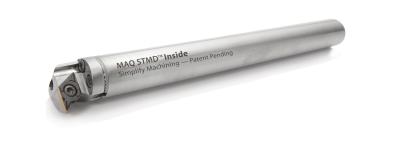
MAQ offers the Self-Tuning Mass Damper (STMD). This toolholder features a tungsten mass inside the tool. It is available in more than a dozen length-diameter combinations. By using the STMD, parts manufacturers, machine tool builders and cutting tool manufacturers can reduce cycle time and cost of ownership by 30 percent, decrease tooling costs by 5-10 percent, cut energy consumption by 2-3 percent and curtail scrap output by 1-2 percent.
“The STMD is totally plug-and-play, and maintenance free,” says Dr. Qilin Fu, MAQ’s CEO and a co-founder of the company. “The STMD technology enables automatic tuning of the mass dampers, without using complex mechatronic systems. It also minimizes the need for tooling changes and is a cost-effective alternative to complex de-vibe tools that require manual adjustment. Given the high volume of machining operations, even the smallest percentage reductions can result in substantial savings. “
The tungsten mass is supported by special polymer discs that have frequency-dependent stiffness. As cutting forces are applied to the tool, vibration occurs on a frequency band. To counteract such movement, the MAQ STMD self-adjusts to that frequency to maximize the mass damping effect.
According to tests conducted at a leading machine tool builder in March 2018, the MAQ STMD showed significantly less displacement than other toolholders and demonstrated superior versatility with respect to speeds, feeds, depth of cut and L/D ratio.
MAQ STMD toolholders improve feeds and speeds, decrease adjustment time and promote superior surface finishes that don’t require secondary operations. With STMD, it becomes unnecessary to slow down, reduce depth of cut or otherwise lengthen cycle time.
Contact Details
Related Glossary Terms
- bandsaw blade ( band)
bandsaw blade ( band)
Endless band, normally with serrated teeth, that serves as the cutting tool for cutoff or contour band machines.
- depth of cut
depth of cut
Distance between the bottom of the cut and the uncut surface of the workpiece, measured in a direction at right angles to the machined surface of the workpiece.
- stiffness
stiffness
1. Ability of a material or part to resist elastic deflection. 2. The rate of stress with respect to strain; the greater the stress required to produce a given strain, the stiffer the material is said to be. See dynamic stiffness; static stiffness.
- toolholder
toolholder
Secures a cutting tool during a machining operation. Basic types include block, cartridge, chuck, collet, fixed, modular, quick-change and rotating.
